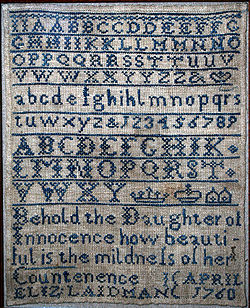Sampler (needlework): Difference between revisions
→Samplers today: eliminated peacock prose |
→External links: external link added see User:VAwebteam/sandbox |
||
| Line 27: | Line 27: | ||
*[http://www.needleworksamplers.com Sampler history and design] |
*[http://www.needleworksamplers.com Sampler history and design] |
||
*[http://www.vam.ac.uk/ Victoria and Albert museum] |
*[http://www.vam.ac.uk/ Victoria and Albert museum] |
||
* {{cite web |publisher= [[Victoria and Albert Museum]] |
|||
|url= http://www.vam.ac.uk/collections/textiles/stories/sampler/index.html |
|||
|title= Sampler story |
|||
|work=Textiles |
|||
|accessdate= 2007-09-03}} |
|||
==Notes== |
==Notes== |
||
Revision as of 12:33, 19 September 2007

A (needlework) sampler is a piece of embroidery produced as a demonstration or test of skill in needlework. It often included the alphabet, figures, motifs, decorative borders and sometimes the name of the person who embroidered it and the date. The word sampler is derived from the Latin ‘exemplum’ - an example.
History
The oldest surviving samplers were constructed in the 15th and 16th centuries. As there were no pre-printed patterns available for needleworkers, a stitched model was needed. Whenever a needlewoman saw a new and interesting example of a stitching pattern, she would quickly sew a small sample of it onto a piece of cloth - her 'sampler'. The patterns were sewn randomly onto the fabric as a reference for future use, and the woman would collect extra stitches and patterns throughout her lifetime.
16th Century English samplers were stitched on a narrow band of fabric 6-9in (15-23cm) wide. As fabric was very expensive, these samplers were totally covered with stitches. These were known as band samplers and valued highly, often being mentioned in wills and passed down through the generations. These samplers were stitched using a variety of needlework styles, threads, and ornament. Many of them were exceedingly elaborate, incorporating subtly shaded colours, silk and metallic embroidery threads, and using stitches such as Hungarian, Florentine, tent, cross, long-armed cross, two-sided Italian cross, rice, running, Holbein, Algerian eye and buttonhole stitches. The samplers also incorporated small designs of flowers and animals, and geometric designs stitched using as many as 20 different colours of thread.

The first printed pattern book was produced in 1523, but they were not easily obtainable and a sampler was the most common form of reference available to many women.
The earliest dated surviving sampler, housed in the Victoria and Albert Museum in London, was made by Jane Bostocke who included her name and the date 1598 in the inscription. However the earliest documentary reference to sampler making is recorded in 1502[1] The household expense accounts of Elizabeth of York record that: 'the tenth day of July to Thomas Fisshe in reward for bringing of concerve of cherys from London to Windsore . . . and for an elne of Iynnyn cloth for a sampler for the Quene'.[2]
A border was added to samplers in the 17th century, and by the middle of the 17th century alphabets became common, with religious or moral quotations, while the entire sampler became more methodically organised. By the 18th century, samplers were a complete contrast to the scattered samples sewn earlier on. These samplers were stitched more to demonstrate knowledge than to preserve skill. The stitching of samplers was believed to be a sign of virtue, achievement and industry, and girls were taught the art from a young age.
Samplers today
Samplers are widely stitched today, some using kits purchased from needlework shops, some from chart-packs, and many from patterns available on the Internet or through e-mail from designers. Patterns range from simple using only one stitch, to complex, using 15 to 20 and more stitches. Designs range widely in style, from accurate reproductions of historic pieces to much more contemporary and modern styles. Many sampler reproductions are also available, copying colors and imperfect stitches from the originals.
Materials used include aida cloth, evenweave, and linen fabrics, in cotton, linen, and man-made materials combined in more and more ways; and fibers from cotton floss to silk, rayon, viscose, and metallic.
See also
External links
- A brief history of embroidery samplers
- Sampler history and design
- Victoria and Albert museum
- "Sampler story". Textiles. Victoria and Albert Museum. Retrieved 2007-09-03.
Notes
References
- Privy Purse Expenses of Elizabeth of York: Wardrobe Accounts of Edward IV at the Richard III Society site, retrieved February 20, 2007
- Fawdry, Marguerite, and Deborah Brown, The Book of Samplers, St. Martin's Press, New York, 1980, ISBN 0-3120-9006-4



